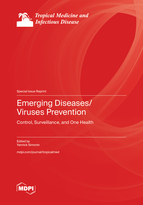Emerging Diseases/Viruses Prevention: Control, Surveillance, and One Health
A special issue of Tropical Medicine and Infectious Disease (ISSN 2414-6366). This special issue belongs to the section "One Health".
Deadline for manuscript submissions: closed (24 December 2022) | Viewed by 54705
Special Issue Editor
Interests: pathogenesis and diagnosis of emerging viruses especially flaviviruses and neurotropic viruses
Special Issues, Collections and Topics in MDPI journals
Special Issue Information
Dear Colleagues,
Zoonoses represent up to 60% of infectious diseases and 75% of new diseases in humans. They can cause considerable economic losses each year, as recently illustrated by the COVID-19 pandemic. Several factors, such as intensive agricultural and livestock practices, human population growth, and international travel, are known to contribute to the emergence of zoonotic diseases. This special issue will cover the topic of One Health and its application in the prevention and control of emerging diseases. The One Health concept recognizes that the health of humans, animals, vectors, and their ecosystems are closely interconnected. To better understand and respond to zoonotic and emerging diseases, there is a need for coordinated, collaborative, multidisciplinary, and cross-sectoral approaches including human health, veterinary health, and environmental health.
In this Special Issue, we invite colleagues to submit original research articles and scientific reviews to assemble a collection of papers highlighting advancements in our understanding of all aspects related to surveillance and control of zoonotic disease, including (but not limited to) 1) development of new diagnostic tools, 2) outbreak investigation and surveillance program of emerging pathogens (including One health approaches), and 3) understanding of the mechanisms of pathogen emergence.
Dr. Yannick Simonin
Guest Editor
Manuscript Submission Information
Manuscripts should be submitted online at www.mdpi.com by registering and logging in to this website. Once you are registered, click here to go to the submission form. Manuscripts can be submitted until the deadline. All submissions that pass pre-check are peer-reviewed. Accepted papers will be published continuously in the journal (as soon as accepted) and will be listed together on the special issue website. Research articles, review articles as well as short communications are invited. For planned papers, a title and short abstract (about 100 words) can be sent to the Editorial Office for announcement on this website.
Submitted manuscripts should not have been published previously, nor be under consideration for publication elsewhere (except conference proceedings papers). All manuscripts are thoroughly refereed through a single-blind peer-review process. A guide for authors and other relevant information for submission of manuscripts is available on the Instructions for Authors page. Tropical Medicine and Infectious Disease is an international peer-reviewed open access monthly journal published by MDPI.
Please visit the Instructions for Authors page before submitting a manuscript. The Article Processing Charge (APC) for publication in this open access journal is 2700 CHF (Swiss Francs). Submitted papers should be well formatted and use good English. Authors may use MDPI's English editing service prior to publication or during author revisions.
Keywords
- emerging diseases
- zoonoses
- surveillance program
- one health
- innovative diagnosis







